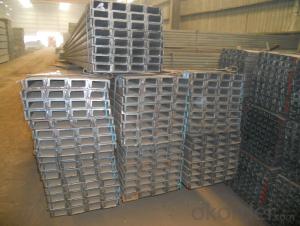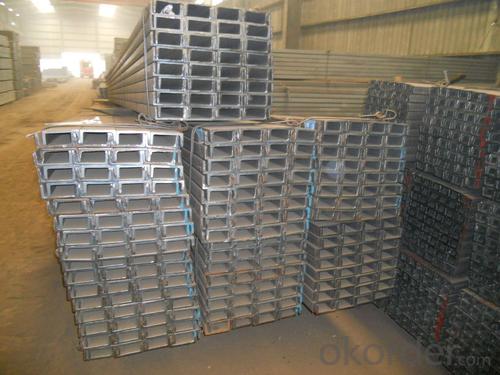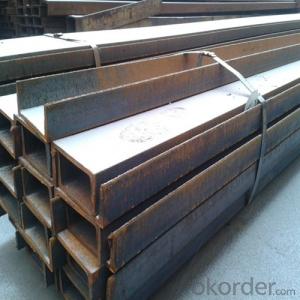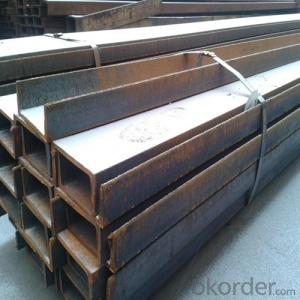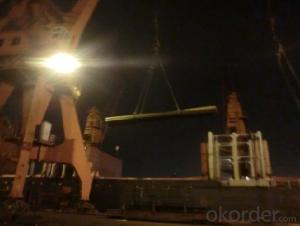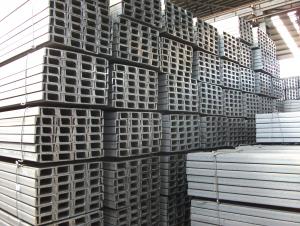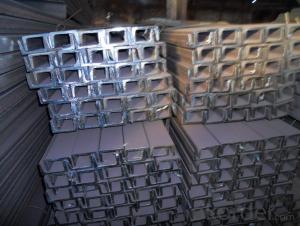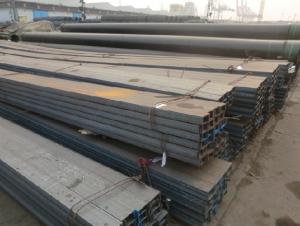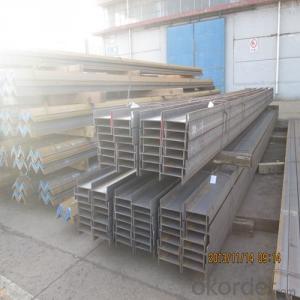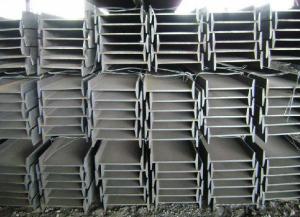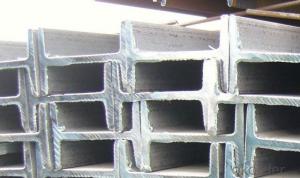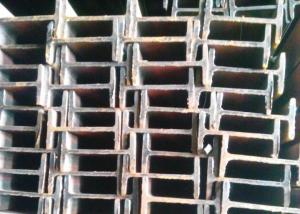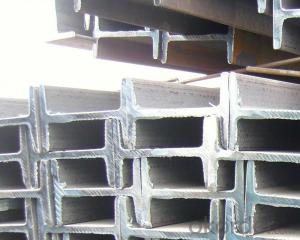Hot Rolled U-Channel Steel with Many Standard
- Loading Port:
- Tianjin
- Payment Terms:
- TT OR LC
- Min Order Qty:
- 20 m.t.
- Supply Capability:
- 1000 m.t./month
OKorder Service Pledge
OKorder Financial Service
You Might Also Like
Product Description:
OKorder is offering Hot Rolled Steel U-Channel at great prices with worldwide shipping. Our supplier is a world-class manufacturer of steel, with our products utilized the world over. OKorder annually supplies products to European, North American and Asian markets. We provide quotations within 24 hours of receiving an inquiry and guarantee competitive prices.
Product Applications:
Hot Rolled Steel U-Channel can be applied to construction of warehouses, workshops, sport stadiums and car parks etc.The hot rolled channel steel belongs to carbon structural steel which is applied to in the field of construction and machinery.In details, the hot rolled channel steel is usually used for arch-itechtural structure, and they could be welded in order to support or hang a vari-ety of facilities. They are also usually used in combination with I beam. Generally,the hot rolled channel steel we supply must possess perfect welding property, riveting property and mechanical property and so on.
Product Advantages:
OKorder's Hot Rolled Steel U-Channel are durable, strong, and resist corrosion.
Main Product Features:
· Premium quality
· Prompt delivery & seaworthy packing (30 days after receiving deposit)
· Corrosion resistance
· Can be recycled and reused
· Mill test certification
· Professional Service
· Competitive pricing
Product Specifications:
We supply high quality MS Channel at reasonable price, including Chinese standard, Japanese standard and so on.
Standard | GB/JIS |
Material Grade | Q235,SS400 |
Technique: | Hot Rolled |
Sizes as per chinese standard: | 50*37*4.5mm - 300*89*11.5mm |
Sizes as per japanese standard: | 50*25*3mm – 200*80*7.5mm |
Length: | 6meter, 9meter, 12meter |
Package & Delivery of MS Channel:
1.The hot rolled channel steel will be packed in bundle with steel wire at each end of every bundle and color marking in order to help the customer to recognize his goods more easily at sight.
2. And the hot rolled channel steel could be loaded into 20ft or 40ft container, or by bulk cargo.If the weight of each bundle reaches more than 3.5 mt, the loading by break bulk cargo should be choosed.When the weight of each bundle reaches less than 3mt, the loading by container should be choosed.
3.As for the transportaion from mill to loading port, the truck will be usually used. And the maximum quantity for each truck is 40mt.
4.All in all, we could do in accordance with customer's request
FAQ:
Q1: Why buy Materials & Equipment from OKorder.com?
A1: All products offered byOKorder.com are carefully selected from China's most reliable manufacturing enterprises. Through its ISO certifications, OKorder.com adheres to the highest standards and a commitment to supply chain safety and customer satisfaction.
Q2: How do we guarantee the quality of our products?
A2: We have established an advanced quality management system which conducts strict quality tests at every step, from raw materials to the final product. At the same time, we provide extensive follow-up service assurances as required.
Q3: How soon can we receive the product after purchase?
A3: Within three days of placing an order, we will begin production. The specific shipping date is dependent upon international and government factors, but is typically 7 to 10 workdays.
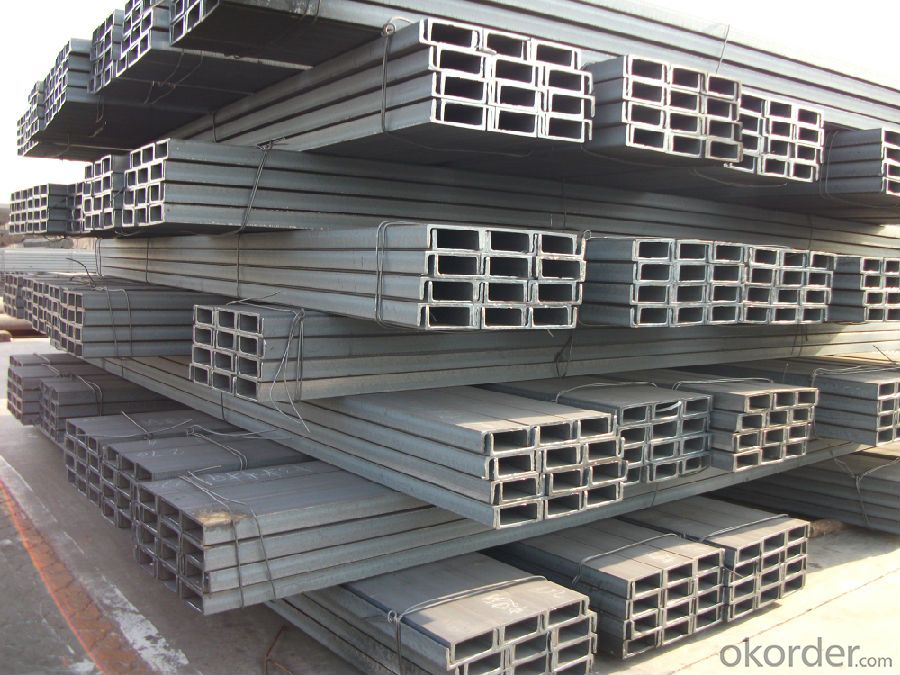
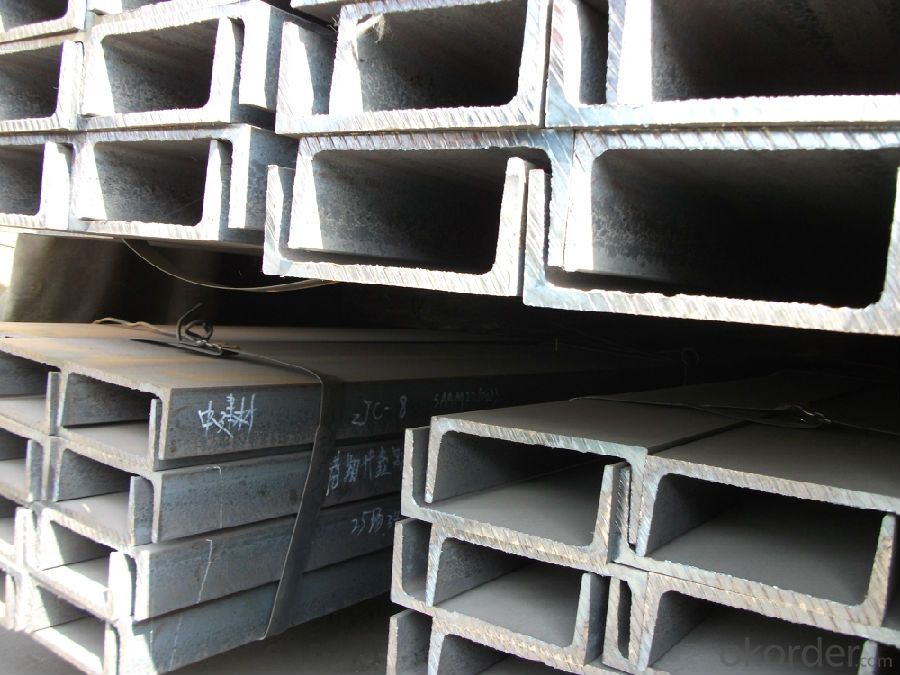
- Q: What are the different types of connections used for Steel I-Beams in bridge construction?
- Bridge construction commonly employs various types of connections for Steel I-Beams. Some commonly used types include: 1. Welded connections: The most frequently used connection in bridge construction involves welding the I-Beams at the joints to create a strong and rigid connection. Welded connections are favored due to their ability to transfer loads effectively and withstand high forces. 2. Bolted connections: This connection entails bolting the I-Beams together using high-strength bolts. Bolted connections allow for easy assembly and disassembly, making them ideal for situations requiring future modifications or relocations. However, they may not offer the same level of rigidity as welded connections. 3. Riveted connections: While riveted connections were once prevalent in bridge construction, they have become less common in modern times. This method involves using metal rivets to join the I-Beams. Although riveted connections can transfer loads effectively, their installation requires skilled labor and specialized equipment. 4. Friction connections: Friction connections employ high-strength bolts and specialized washers to create a connection reliant on surface friction for load transfer. This type of connection allows for some movement due to thermal expansion and contraction, making it suitable for long-span bridges where thermal effects are significant. Each connection type possesses its own advantages and disadvantages. The choice of connection depends on factors like design requirements, bridge location, anticipated loads, and construction methods. Selecting the appropriate connection type is crucial to ensure the bridge's structural integrity and longevity.
- Q: Are I-beam and H steel the same thing?
- First of all, H steel flange width, and secondly, the inner edge of the flange has no slope, parallel to the upper and lower surfaces. The section characteristic of H steel is obviously better than that of traditional i-beam. Type steel flange head, flange surface with gradient (1: 6), the flange is thin and thick, resulting in two main I-beam section characteristic plane is huge, it is difficult to play the strength characteristics of steel in the application. I-beam has been gradually eliminated by section H steel.I-beam, also called steel girder, is a long strip steel with cross section. Simple to distinguish from the surface: steel side of small, high height, can only bear the force of single direction. The H steel groove is deep and big in thickness and can bear two directions of force. With the development of steel structure construction, only I-beam is not available, that is thickening I-beam, used for load-bearing columns, easy to instability. I-beam can only be used for cross beams, and H steel can be used for structural load-bearing columns.
- Q: Are steel I-beams suitable for supporting glass curtain walls?
- Indeed, steel I-beams are indeed appropriate for the purpose of supporting glass curtain walls. The utilization of steel I-beams is widespread in the field of construction owing to their exceptional strength and ability to bear heavy loads. They fulfill the essential role of providing the necessary structural support needed to sustain the weight of the glass panels within a curtain wall system. Furthermore, steel I-beams can be tailored to meet specific design criteria and can be seamlessly incorporated into the building's framework. This facilitates the creation of capacious areas with expansive glass exteriors that are visually appealing while simultaneously upholding structural integrity. In summary, steel I-beams are a dependable and commonly employed option for supporting glass curtain walls in construction endeavors.
- Q: How long do Steel I-Beams last?
- Steel I-beams have a remarkably long lifespan and can last for several decades, if not longer, depending on various factors. The durability and longevity of steel I-beams are primarily attributed to the inherent strength and resistance of steel as a construction material. When properly designed, manufactured, and maintained, steel I-beams can withstand heavy loads, extreme weather conditions, and other environmental factors that could potentially degrade their structural integrity. The lifespan of steel I-beams depends on several factors, including the quality of the steel used, the design and engineering of the structure, the level of maintenance provided, and the conditions under which the beams are exposed. High-quality steel, such as structural-grade steel, is specifically engineered to provide exceptional strength, corrosion resistance, and longevity. These beams are often galvanized or coated with protective finishes to further enhance their resistance to rust and corrosion. Additionally, the design and engineering of the structure play a crucial role in determining the lifespan of steel I-beams. Properly designed structures that evenly distribute loads and minimize stress concentrations can significantly extend the lifespan of the beams. Regular maintenance, including inspections, repairs, and the application of anti-corrosion treatments, can also enhance their durability and extend their lifespan. In ideal conditions, with appropriate maintenance and care, steel I-beams can last well over 50 years. However, it is important to note that certain factors can potentially reduce their lifespan. These factors include exposure to harsh environments, such as coastal areas with high salt content in the air, constant exposure to moisture or chemicals, and inadequate maintenance practices. Additionally, any structural modifications, improper repairs, or accidental damage can also impact the lifespan of steel I-beams. To ensure the longevity of steel I-beams, it is recommended to consult with structural engineers and adhere to maintenance guidelines provided by manufacturers. Regular inspections, prompt repairs, and appropriate maintenance practices are essential to maximize the lifespan of steel I-beams and ensure the safety and stability of the structures they support.
- Q: What are the cost implications of using steel I-beams in construction?
- The cost implications of using steel I-beams in construction can vary depending on various factors. Steel I-beams are generally more expensive compared to other materials like wood or concrete. However, they offer several benefits such as superior strength, durability, and flexibility in design. The initial cost of steel I-beams may be higher, but they require less maintenance and have a longer lifespan, which can result in cost savings in the long run. Additionally, steel I-beams can be lighter and require fewer supporting columns, reducing construction time and labor costs. It's important to consider the specific project requirements, structural needs, and long-term maintenance when evaluating the cost implications of using steel I-beams in construction.
- Q: Are steel I-beams suitable for supporting rooftop helipads?
- Steel I-beams are indeed suitable for supporting rooftop helipads. I-beams are known for their strength and load-bearing capabilities, making them ideal for such structural applications. Steel is a commonly used material in construction due to its high tensile strength and durability, making it capable of withstanding the weight and impact associated with helicopter landings and takeoffs. Additionally, steel I-beams can be designed and engineered to meet specific load requirements, ensuring the necessary support for a helipad. The versatility and reliability of steel I-beams make them a popular choice for supporting rooftop helipads in various buildings and structures.
- Q: Can steel I-beams be used in both residential and commercial construction?
- Yes, steel I-beams can be used in both residential and commercial construction. Steel I-beams are a popular choice in construction due to their strength, durability, and versatility. In residential construction, steel I-beams can be used as load-bearing components to support the weight of the structure, such as in the construction of larger homes or multi-story buildings. They are commonly used to create open floor plans, allowing for wider spans and fewer support columns, providing more design flexibility. In commercial construction, steel I-beams are extensively used in the construction of large-scale buildings, such as office complexes, warehouses, and shopping centers. They offer superior structural integrity, allowing for taller buildings and larger open spaces. Additionally, steel I-beams are fire-resistant, making them a preferred choice in both residential and commercial construction for their safety features. Overall, steel I-beams are a versatile and reliable option for both residential and commercial construction projects.
- Q: How do steel I-beams contribute to sustainable construction?
- Steel I-beams contribute to sustainable construction in several ways: 1. Durability: Steel I-beams are highly durable and can withstand extreme weather conditions, earthquakes, and fire. This longevity reduces the need for frequent repairs or replacements, thereby reducing material waste and resource consumption over the lifespan of a building. 2. Recyclability: Steel is one of the most recyclable materials on the planet. Steel I-beams can be easily recycled at the end of their life cycle without losing their structural integrity. This reduces the demand for new steel production and conserves natural resources, energy, and emissions associated with the mining and manufacturing of virgin materials. 3. Energy efficiency: Steel I-beams can be fabricated off-site in controlled conditions, allowing for accurate sizing and reduced waste during construction. The precise dimensions and lightweight nature of steel also help optimize the design and construction process, resulting in the efficient use of materials and reduced transportation costs. 4. Versatility: Steel I-beams offer design flexibility, allowing architects and engineers to create open, airy spaces with minimal support columns. This versatility not only enhances the aesthetic appeal of a building but also maximizes the use of natural light and ventilation, reducing the need for artificial lighting and HVAC systems. This, in turn, reduces energy consumption and greenhouse gas emissions. 5. Sustainable supply chain: The steel industry has made significant efforts to reduce its environmental impact. Many steel manufacturers have implemented sustainable practices such as using recycled content, minimizing water use, and improving energy efficiency in their production processes. By choosing steel I-beams, builders can support these sustainable practices and contribute to a more sustainable supply chain. Overall, steel I-beams contribute to sustainable construction by providing durable, recyclable, energy-efficient, and versatile building materials. Their use reduces waste, conserves natural resources, and minimizes the environmental impact of the construction industry.
- Q: How are steel I-beams transported and installed?
- Steel I-beams are typically transported and installed using heavy machinery and specialized equipment due to their size and weight. The transportation process involves loading the I-beams onto a flatbed truck or a trailer specifically designed for carrying large and heavy loads. These trucks are equipped with cranes or other lifting mechanisms to safely load and unload the I-beams at the construction site. Upon arrival at the site, the I-beams are carefully unloaded and positioned using cranes and hoists. The installation process requires a team of skilled workers who work together to lift, position, and secure the I-beams in place. The beams are often connected to other structural elements, such as columns or girders, using bolts or welding techniques to ensure stability and structural integrity. Before installation, precise measurements and calculations are made to determine the appropriate size and placement of the I-beams. This ensures that the beams can withstand the loads and stresses they will be subjected to during their intended use. Proper alignment and leveling are crucial during installation to ensure the overall structural stability of the building or structure. Safety precautions are paramount throughout the entire transportation and installation process. Workers involved in handling and positioning the I-beams are required to wear protective gear, such as hard hats and safety harnesses. Additionally, rigorous safety protocols are followed to prevent accidents and ensure the well-being of all workers on site. In summary, the transportation and installation of steel I-beams involves the use of heavy machinery, skilled workers, and careful planning. These beams play a crucial role in supporting the weight and loads of buildings and structures, and their proper installation is essential for ensuring structural integrity and safety.
- Q: Can steel I-beams be used for educational institutions?
- Yes, steel I-beams can be used for educational institutions. Steel I-beams are commonly used in construction due to their high strength and load-bearing capabilities. They can provide structural support for buildings, including educational institutions, ensuring safety and stability. Additionally, steel I-beams offer design flexibility, allowing for spacious and open interior spaces within educational buildings.
Send your message to us
Hot Rolled U-Channel Steel with Many Standard
- Loading Port:
- Tianjin
- Payment Terms:
- TT OR LC
- Min Order Qty:
- 20 m.t.
- Supply Capability:
- 1000 m.t./month
OKorder Service Pledge
OKorder Financial Service
Similar products
Hot products
Hot Searches
Related keywords
